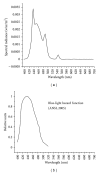The visual effects of intraocular colored filters
- PMID: 24278692
- PMCID: PMC3820566
- DOI: 10.6064/2012/424965
The visual effects of intraocular colored filters
Abstract
Modern life is associated with a myriad of visual problems, most notably refractive conditions such as myopia. Human ingenuity has addressed such problems using strategies such as spectacle lenses or surgical correction. There are other visual problems, however, that have been present throughout our evolutionary history and are not as easily solved by simply correcting refractive error. These problems include issues like glare disability and discomfort arising from intraocular scatter, photostress with the associated transient loss in vision that arises from short intense light exposures, or the ability to see objects in the distance through a veil of atmospheric haze. One likely biological solution to these more long-standing problems has been the use of colored intraocular filters. Many species, especially diurnal, incorporate chromophores from numerous sources (e.g., often plant pigments called carotenoids) into ocular tissues to improve visual performance outdoors. This review summarizes information on the utility of such filters focusing on chromatic filtering by humans.
Figures






References
-
- Tanito M, Okuno T, Ishiba Y, Ohira A. Transmission spectrums and retinal blue-light irradiance values of untinted and yellow-tinted intraocular lenses. Journal of Cataract and Refractive Surgery. 2010;36(2):299–307. - PubMed
-
- Mukai K, Matsushima H, Sawano M, Nobori H, Obara Y. Photoprotective effect of yellow-tinted intraocular lenses. Japanese Journal of Ophthalmology. 2009;53(1):47–51. - PubMed
-
- Hammond BR, Jr., Bernstein B, Dong J. The effect of the acrysof natural lens on glare disability and photostress. American Journal of Ophthalmology. 2009;148(2):272–e2. - PubMed
-
- Provines WF, Rahe AJ, Block MG, Pena T, Tredici TJ. Yellow lens effects upon visual acquisition performance. Aviation Space and Environmental Medicine. 1992;63(7):561–564. - PubMed
Publication types
LinkOut - more resources
Full Text Sources
Other Literature Sources

